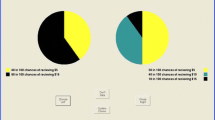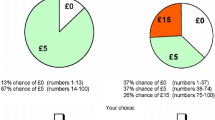Abstract
Understanding choice under risk requires knowledge of beliefs and preferences. A variety of methods have been proposed to elicit peoples’ beliefs. The efficacy of alternative methods, however, has not been rigorously documented. Herein we use an experiment to test whether an induced probability can be recovered using an elicitation mechanism based on peoples’ predictions about a random event. We are unable to recover the induced belief. Instead, the estimated belief is systematically biased in a way that is consistent with anecdotal evidence in the economics, psychology, and statistics literature: people seem to overestimate low and underestimate high probabilities.
Similar content being viewed by others
References
Aitkin, M. (1991). “Posterior Bayes Factors,” Journal of the Royal Statistical Society, Series B 53, 111–142.
Akaike, H. (1973). “Information Theory and an Extension of the Maximum Likelihood Principle.” In N. Petrov and F. Csadki (eds.), Proceedings of the 2{nd} International Symposium on Information Theory. Budapest: Akademiai Kiado.
Beach, L. R. and L. D. Philips. (1967). “Subjective Probabilities Inferred from Estimator Bets,” Journal of Experimental Psychology 75, 354–359.
Croson, Rachel T. A. (2000). “Thinking Like a Game Theorist: Factors Affecting the Frequency of Equilibrium Play,” Journal of Economic Behavior and Organization 41, 299–314.
Dufwenberg, M. and U. Gneezy. (2000). “Measuring Beliefs in an Experimental Lost Wallet Game,” Games and Economic Behavior 30, 163–182.
Edwards, W. (1968). “Conservatism in Human Information Processing.” In B. Kleinmuntz (ed.), Formal Representation of Human Judgement. New York: Wiley, pp. 17–52.
El Gamal, M. A. and D. M. Grether. (1995). “Are People Bayesian? Uncovering Behavioral Strategies,” Journal of the American Statistical Association 90, 1137–1145.
Grether, D. M. (1980). “Bayes Rule as a Descriptive Model: The Representative Heuristic,” Quarterly Journal of Economics November, 537–557.
Grether, D. M. (1992). “Testing Bayes Rule and the Representative Heuristic: Experimental Evidence,” Journal of Economic Behavior and Organization 17, 31–57.
Harless, D. W. and C. F. Camerer. (1994). “The Predictive Utility of Generalized Expected Utility Theories,” Econometrica 62, 1251–1289.
Jaffray, J.-Y. and E. Karni. (1999). “Elicitation of Subjective Probabilities when the Initial Endowment is Unobservable,” Journal of Risk and Uncertainty 8, 5–20.
Jianakoplos, N. A. and A. Bernasek. (1998). “Are Women More Risk Averse?” Economic Inquiry 36, 620– 630.
Kahneman, D. and A. Tversky. (1979). “Prospect Theory: An Analysis of Decision under Risk,” Econometrica 47, 263–291
Karni, E. and Z. Safra. (1995). “The Impossibility of Experimental Elicitation of Subjective Probabilities,” Theory and Decision38, 313–320.
Machina, M. J. (1987). “Choice Under Uncertainty: Problems Solved and Unsolved,” Journal of Economic Perspectives 1, 124–154.
McKelvey, R. D. and T. Page. (1990). “Public and Private Information: An Experimental Study of Information Pooling,” Econometrica 58, 1321–1339.
Norris, P. E. and R. A. Kramer. (1990). “The Elicitation of Subjective Probabilities with Applications in Agricultural Economics,” Review of Marketing and Agricultural Economics 58, 127–147.
Nyarko, Y. and A. Schotter. (2002). “An Experimental Study of Belief Learning Using Elicited Beliefs,” Econometrica 70, 971–1005.
Offerman, T., J. Sonnemans, and A. Schram. (1996). “Value Orientations, Expectations and Voluntary Contributions in Public Goods,” Economic Journal 106, 817–845.
Powell, M. and D. Ansic. (1997). “Gender Differences in Risk Behaviour in Financial Decision Making: An Experimental Analysis,” Journal of Economic Psychology 18, 605–628.
Savage, L. J. (1954). The Foundations of Statistics. New York: John Wiley and Sons.
Savage, L. J. (1971). “Elicitation of Personal Probabilities and Expectation Formation,” Journal of the American Statistical Association 66, 783–801.
Schaefer, R. E. and K. Borcherding. (1973). “The Assessment of Subjective Probability Distributions: A Training Experiment,” Acta Psychologica 37, 117–129.
Schubert, R., M. Brown, M. Gysler, and H. W. Brachinger. (1999). “Financial Decision-Making: Are Women Really More Risk-Averse?” American Economic Review Papers and Proceedings 89, 381–385.
Schwarz, G. (1978). “Estimating the Dimension of a Model,” Annals of Statistics 6, 461–464.
Stahl, D. O. and P. W. Wilson. (1995). “On Players’ Models of Other Players: Theory and Experimental Evidence,” Games and Economic Behavior 10, 218–254.
Sundén, A. E. and B. J. Surette. (1998). “Gender Differences in the Allocation of Assets in Retirement Savings Plans,” American Economic Review Papers and Proceedings 88, 207–211.
Titterington, D. M., A. F. M. Smith, and U. E. Makov. (1985). Statistical Analysis of Finite Mixture Distributions. Chichester: Wiley.
Viscusi, W. K. (1992). Fatal Tradeoffs. New York: Oxford University Press.
Winkler, R. L. (1967). “The Assessment of Prior Distributions in Bayesian Analysis,” Journal of the American Statistical Association 62, 776–800.
Author information
Authors and Affiliations
Corresponding author
Rights and permissions
About this article
Cite this article
Hurley, T.M., Shogren, J.F. An Experimental Comparison of Induced and Elicited Beliefs. J Risk Uncertainty 30, 169–188 (2005). https://doi.org/10.1007/s11166-005-6565-5
Issue Date:
DOI: https://doi.org/10.1007/s11166-005-6565-5




